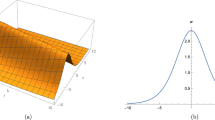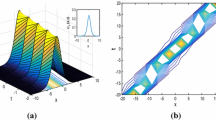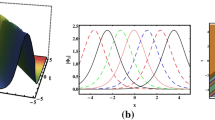Abstract
The nonlinear longitudinal wave equation, describing the propagation of optical solitons in magneto-electro-elastic circular rod, is investigated analytically. Two integration tools that are traveling wave hypothesis and G\(^{\prime }\)/G expansion scheme are recruited to extract explicit soliton solutions. The existence conditions are derived.
Similar content being viewed by others
Explore related subjects
Discover the latest articles, news and stories from top researchers in related subjects.Avoid common mistakes on your manuscript.
1 Introduction
Recently, the study of nonlinear dynamics of optical solitons in magneto-electro-elastic (MEE) media (such as sensors, actuators, controllers) has attracted a lot of interest [1–20]. As we all know, the governing equation that describes the propagation of optical solitons through MEE media is modeled by the nonlinear longitudinal wave equation (NLWE). Many integration algorithms including variation principle, Jacobi elliptic function expansion approach and ansatz scheme were proposed to solve the NLWE, and explicit solitary wave solutions were reported in the past [1–3]. However, this paper will apply two different ways to extract exact soliton solutions to NLWE. They are traveling wave hypothesis and G\(^{\prime }\)/G expansion scheme [21–42]. Therefore, this work is an extension of the previous studies.
Under investigation in this work is the following NLWE [1, 2]:
where q(x, t) is the complex wave profile, while t and x are the time and longitudinal coordinates.
In Eq. (1), \(a=-c_0^2,\, b=-\frac{1}{2}c_0^2 \) and \(c=-N\). \(c_0\) gives linear longitudinal wave velocity for a MEE circular rod, while N represents dispersion parameter. It should be noted that both the coefficients of \(c_0 \) and N depend on material properties and geometry of the rod [1, 2].
In order to obtain analytical traveling wave solutions to Eq. (1), the starting hypothesis is given by
where B is the wave number, and v represents the wave velocity.
Substituting Eq. (2) into Eq. (1) leads to
where the prime denotes differentiation with respect to the variable \(\xi \).
Integrating Eq. (3) twice with respect to \(\xi \), and taking the integration constants equal to zero, one obtains
In the following two subsections, we will perform the traveling wave hypothesis and G\(^{\prime }\)/G expansion scheme on construction of analytical solitary wave solutions to Eq. (4). As a consequence, explicit dark and singular soliton solutions to Eq. (1) are obtained along with the corresponding constraints.
2 Traveling wave hypothesis
Separating variables and integrating once more, Eq. (4) becomes to
where \(a_2 =-\frac{v^{2}+a}{cB^{2}v^{2}}\) and \(a_3 =-\frac{2b}{3cB^{2}v^{2}}\).
From Eq. (5), exact singular periodic solution, bright and singular soliton solutions can be derived, which are listed as follows:
Case 1: Singular periodic solution
When \((v^{2}+a)c>0\), Eq. (5) admits a solution in the form
Finally, explicit singular periodic solution to Eq. (1) is given by
Case 2: Soliton solutions
When \((v^{2}+a)c<0\), Eq. (5) admits the following exact solutions:
and
Finally, explicit bright soliton solution to Eq. (1) is given by
and explicit singular soliton solution to Eq. (1) is given by
3 G\(^{\prime }\)/G expansion scheme
According to the balancing principle, Eq. (4) admits the solution in the form
where \(a_i \) for \(i=0,\;1,\;2\) are real constants to be determined later, and \(G(\xi )\) satisfies
Putting Eqs. (12) and (13) into Eq. (4), and then taking the coefficients of \(\left( {\frac{{G}'(\xi )}{G(\xi )}} \right) ^{m} \,(m=0,\;1,\;2,\;3,\;4)\) to zero yields
Solving the above nonlinear system, one obtains the following results:
Case 1:
where \(\lambda ,\, B\) and v are arbitrary constants.
Substituting Eqs. (19)–(22) into Eq. (12), and using the solutions of Eq. (13), one can get analytical solitary wave solutions to Eq. (1), which are listed as follows:
(1) When \((v^{2}+a)c<0\), Eq. (1) admits explicit hyperbolic function solitary wave solution
where \(C_1 \) and \(C_2 \) are arbitrary constants.
If we take \(C_1 =0\) and \(C_2 \ne 0\), the solution (23) degenerates to singular soliton
and if we take \(C_2 =0\) and \(C_1 \ne 0\), the solution (23) becomes to solitary wave
(2) When \((v^{2}+a)c>0\), Eq. (1) admits exact trigonometric function solitary wave solution
where \(C_1 \) and \(C_2 \) are arbitrary constants.
If we take \(C_1 =0\) and \(C_2 \ne 0\), the solution (26) degenerates to a singular periodic solution
and if we take \(C_2 =0\) and \(C_1 \ne 0\), the solution (26) becomes to other singular periodic solution
(3) When \(a=-v^{2}\), Eq. (1) admits analytical plane-wave solution
where \(C_1 \) and \(C_2 \) are arbitrary constants.
Case 2:
where \(\lambda ,\, B\) and v are arbitrary constants.
Substituting Eqs. (30)–(33) into Eq. (12), and using the solutions of Eq. (13), one can get analytical solitary wave solutions to Eq. (1), which are listed as follows:
(1) When \((v^{2}+a)c>0\), Eq. (1) admits explicit hyperbolic function solitary wave solution
where \(C_1 \) and \(C_2\) are arbitrary constants.
If we take \(C_1 =0\) and \(C_2 \ne 0\), the solution (34) degenerates to singular soliton
and if we take \(C_2 =0\) and \(C_1 \ne 0\), the solution (34) becomes to dark soliton
(2) When \((v^{2}+a)c<0\), Eq. (1) admits exact trigonometric function solitary wave solution
where \(C_1 \) and \(C_2 \) are arbitrary constants.
If we take \(C_1 =0\) and \(C_2 \ne 0\), the solution (37) degenerates to a singular periodic solution
and if we take \(C_2 =0\) and \(C_1 \ne 0\), the solution (26) becomes to other singular periodic solution
(3) When \(a=-v^{2}\), Eq. (1) admits analytical plane-wave solution
where \(C_1 \) and \(C_2 \) are arbitrary constants.
4 Conclusion
This work studies the nonlinear dynamics of optical solitons in MEE media. The NLWE is solved analytically. Two integration tools are used to construct exact solitons. We first obtain the singular periodic solution, bright and singular soliton solutions by traveling wave hypothesis. Then, we report hyperbolic function solitary wave solutions, trigonometric function solitary wave solutions and plane-wave solutions by the G\(^{\prime }\)/G expansion scheme. It should be noted that the singular periodic solutions, bright and singular soliton solutions can be derived by choosing appropriate parameter values of \(C_1 \) and \(C_2 \).
References
Younis, M., Ali, S.: Bright, dark, and singular solitons in magneto-electro-elastic circular rod. Waves Random Complex Media. doi:10.1080/17455030.2015.1058993
Xue, C.X., Pan, E., Zhang, S.Y.: Solitary waves in a magneto-electro-elastic circular rod. Smart Mater. Struct. 20, 105010 (2011)
Liu, Z., Zhang, S.: Nonlinear waves and periodic solution in finite deformation elastic rod. Acta Mech. Solida Sin. 19, 1 (2006)
Biswas, A.: 1-soliton solution of the generalized Zakharov–Kuznetsov modified equal width equation. Appl. Math. Lett. 22, 1775 (2009)
Biswas, A., Zerrad, E.: 1-soliton solution of the Zakharov–Kuznetsov equation with dual-power law nonlinearity. Commun. Nonlinear Sci. Numer. Simul. 14, 3574 (2009)
Biswas, A.: Topological and non-topological solitons for the generalized Zakharov–Kuznetsov modified equal width equation. Int. J. Theor. Phys. 48, 2698 (2009)
Biswas, A.: 1-Soliton solution of the generalized Zakharov–Kuznetsov equation with nonlinear dispersion and time-dependent coefficients. Phys. Lett. A 373, 2931 (2009)
Biswas, A., Zerrad, E., Gwanmesia, J., Khouri, R.: 1-soliton solution of the generalized Zakharov equation in plasmas by He’s variational principle. Appl. Math. Comput. 215, 4462 (2010)
Biswas, A., Zerrad, E.: Solitary wave solution of the Zakharov–Kuznetsov equation in plasmas with power law nonlinearity. Nonlinear Anal. Real World Appl. 11, 3272 (2010)
Krishnan, E.V., Biswas, A.: Solutions to the Zakharov–Kuznetsov equation with higher order nonlinearity by mapping and ansatz methods. Phys. Wave Phenom. 18, 256 (2010)
Suarez, P., Biswas, A.: Exact 1-soliton solution of the Zakharov equation in plasmas withpower law nonlinearity. Appl. Math. Comput. 217, 7372 (2011)
Matebese, B.T., Adem, A.R., Khalique, C.M., Biswas, A.: Solutions of Zakharov–Kuznetsov equation with power law nonlinearity in (1+3) dimensions. Phys. Wave Phenom. 19, 148 (2011)
Johnpillai, A.G., Kara, A.H., Biswas, A.: Symmetry solutions and reductions of a class of generalized (2+1)-dimensional Zakharov–Kuznetsov Equation. Int. J. Nonlinear Sci. Numer. Simul. 12, 45 (2011)
Ebadi, G., Mojaver, A., Milovic, D., Johnson, S., Biswas, A.: Solitons and other solutions to the quantum Zakharov–Kuznetsov equation. Astrophys. Space Sci. 341, 507 (2012)
Biswas, A., Song, M.: Soliton solution and bifurcation analysis of the Zakharov–Kuznetsov–Benjamin–Bona–Mahoney equation with power law nonlinearity. Commun. Nonlinear Sci. Numer. Simul. 18, 1676 (2013)
Bhrawy, A.H., Abdelkawy, M.A., Kumar, S., Johnson, S., Biswas, A.: Solitons and other solutions to quantum Zakharov–Kuznetsov equation in quantum magneto-plasmas. Indian J. Phys. 87, 455 (2013)
Morris, R., Kara, A.H., Biswas, A.: Soliton solution and conservation laws of the Zakharov equation in plasmas with power law nonlinearity. Nonlinear Anal. Model Control 18, 153 (2013)
Ahmed, B.S., Zerrad, E., Biswas, A.: Kinks and domain walls of the Zakharov equation in plasmas. Proc. Roman. Acad. A 14, 281 (2013)
Song, M., Ahmed, B.S., Zerrad, E., Biswas, A.: Domain wall and bifurcation analysis of the Klein–Gordon Zakharov equation in (1+ 2)-dimensions with power law nonlinearity. Chaos 23, 033115 (2013)
Wang, G.W., Xu, T.Z., Johnson, S., Biswas, A.: Solitons and Lie group analysis to an extended quantum Zakharov–Kuznetsov equation. Astrophys. Space Sci. 349, 317 (2014)
Mirzazadeh, M., Eslami, M., Biswas, A.: 1-Soliton solution of KdV6 equation. Nonlinear Dyn. 80, 387 (2015)
Mirzazadeh, M., Arnous, A.H., Mahmood, M.F., Zerrad, E., Biswas, A.: Soliton solutions to resonant nonlinear Schrödinger’s equation with time-dependent coefficients by trial solution approach. Nonlinear Dyn. 81, 277 (2015)
Mirzazadeh, M., Eslami, M., Zerrad, E., Mahmood, M.F., Biswas, A., Belic, M.: Optical solitons in nonlinear directional couplers by sine–cosine function method and Bernoulli’s equation approach. Nonlinear Dyn. 81, 1933 (2015)
Vega-Guzman, J., Hilal, E.M., Alshaery, A.A., Bhrawy, A.H., Mahmood, M.F., Moraru, L., Biswas, A.: Thirring optical solitons with spatio–temporal dispersion. Proc. Roman. Acad. A 16, 41 (2015)
Wang, G., Xu, T.: Optical soliton of time fractional Schrödinger equations with He’s semi-inverse method. Laser Phys. 25, 5402 (2015)
Wazwaz, A.M.: Multiple soliton solution for two integrable couplings of the modified Korteweg–de Vries equation. Proc. Roman. Acad. A 14, 219 (2013)
Zhou, Q.: Optical solitons in the parabolic law media with high-order dispersion. Optik 125, 5432 (2014)
Guo, R., Liu, Y.F., Hao, H.Q., Qi, F.H.: Coherently coupled solitons, breathers and rogue waves for polarized optical waves in an isotropic medium. Nonlinear Dyn. 80, 1221 (2015)
Dai, C.Q., Zhang, J.F.: Controllable dynamical behaviors for spatiotemporal bright solitons on continuous wave background. Nonlinear Dyn. 73, 2049 (2013)
Zhou, Q., Yao, D., Ding, S., Zhang, Y., Chen, F., Chen, F., Liu, X.: Spatial optical solitons in fifth order and seventh order weakly nonlocal nonlinear media. Optik 124, 5683 (2013)
Wang, M.L., Li, X., Zhang, J.: The G’/G-expansion method and travelling wave solutions of nonlinear evolution equations in mathematical physics. Phys. Lett. A 372, 417 (2008)
Zhu, H.P.: Spatiotemporal solitons on cnoidal wave backgrounds in three media with different distributed transverse diffraction and dispersion. Nonlinear Dyn. 76, 1651 (2014)
Zhong, W.P., Belić, M.: Breather solutions of the generalized nonlinear Schrödinger equation with spatially modulated parameters and a special external potential. Eur. Phys. J. Plus 129, 1 (2014)
Zhou, Q.: Analytical solutions and modulation instability analysis to the perturbed nonlinear Schrödinger equation. J. Mod. Opt. 61, 500 (2014)
Zhou, Q., Yao, D., Chen, F., Li, W.: Optical solitons in gas-filled, hollow-core photonic crystal fibers with inter-modal dispersion and self-steepening. J. Mod. Opt. 60, 854 (2013)
Leblond, H., Triki, H., Mihalache, D.: Theoretical studies of ultrashort-soliton propagation in nonlinear optical media from a general quantum model. Rom. Rep. Phys. 65, 925 (2013)
Zhou, Q., Yao, D., Xu, Q., Liu, X.: Optical soliton perturbation with time- and space-dependent dissipation (or gain) and nonlinear dispersion in Kerr and non-Kerr media. Optik 124, 2368 (2013)
Huang, L.G., Liu, W.J., Huang, P., Pan, N., Lei, M.: Soliton amplification in gain medium governed by Ginzburg–Landau equation. Nonlinear Dyn. 81, 1133 (2015)
Kong, L.Q., Dai, C.Q.: Some discussions about variable separation of nonlinear models using Riccati equation expansion method. Nonlinear Dyn. 81, 1553 (2015)
Zhou, Q., Zhu, Q., Yu, H., Xiong, X.: Optical solitons in media with time-modulated nonlinearities and spatiotemporal dispersion. Nonlinear Dyn. 80, 983 (2015)
Zhou, Q., Liu, L., Liu, Y., Yu, H., Yao, P., Wei, C., Zhang, H.: Exact optical solitons in metamaterials with cubic-quintic nonlinearity and third-order dispersion. Nonlinear Dyn. 80, 1365 (2015)
Savescu, M., Bhrawy, A.H., Alshaery, A.A., Hilal, E.M., Khan, K.R., Mahmood, M.F., Biswas, A.: Optical solitons in nonlinear directional couplers with spatio–temporal dispersion. J. Mod. Opt. 61, 441 (2014)
Acknowledgments
This work was supported by the Natural Science Foundation of Hubei Province of China under Grant Number 2015CFC891.
Author information
Authors and Affiliations
Corresponding author
Rights and permissions
About this article
Cite this article
Zhou, Q. Analytical study of solitons in magneto-electro-elastic circular rod. Nonlinear Dyn 83, 1403–1408 (2016). https://doi.org/10.1007/s11071-015-2412-7
Received:
Accepted:
Published:
Issue Date:
DOI: https://doi.org/10.1007/s11071-015-2412-7




